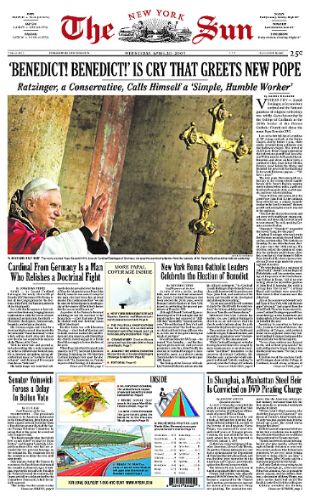The New York Sun
About Andrew Cusack
 Writer, web designer, etc.; born in New York; educated in Argentina, Scotland, and South Africa; now based in London.
Writer, web designer, etc.; born in New York; educated in Argentina, Scotland, and South Africa; now based in London. read more
News
Blogs
Reviews & Periodicals
Arts & Design
World
France
Mitteleuropa
Knickerbockers
Argentina
The Levant
Africa
Cape of Good Hope
Netherlands
Scandinavia
Québec
India
Muscovy
Germany
Academica
New York Sun will no longer shine for all
Center-right New York daily will cease printing at end of month
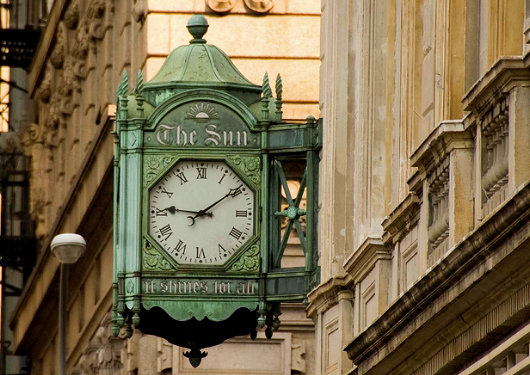
In a devastating blow to the intellectual life of the city, the New York Sun editor Seth Lipsky announced today that the small-but-influential daily newspaper will cease operations at the end of the month unless new investors can be found to put many millions of dollar into the revived title. The newspaper — known for its excellent arts & cultural coverage and willingness to lift the veil on corruption in addition to its hardcore neoconservative politics — is believed to be operating at a loss of tens of millions of dollars a year. Seth Lipsky announced the perilous state of the Sun in a letter to readers this morning:
The Sad State of the Modern Newspaper
…and the heroism of an Anglo-Hungarian countess.
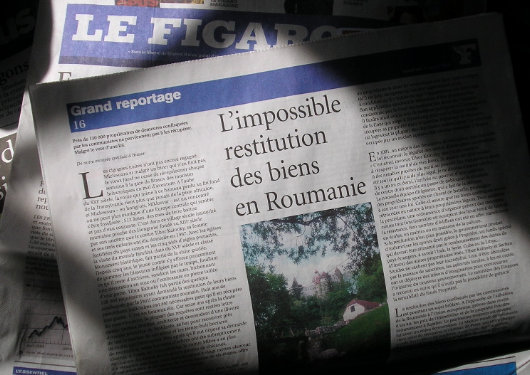
IT IS ONE OF THE more saddening facts of life that British newspapers have suffered an inexorable decline in the past few years. The great Times of London – once the most respected newspaper in the world – has been reduced to a boring mid-brow tabloid, the once-solid Scotsman idiotified and, again, tabloided, and of course the Daily Telegraph, which has gone from staunchly conservative (as in worldview) to merely Conservative (as in the tribe of Britons who prefer blue to red).
The Telegraph, like the Conservative party itself, doesn’t seem to know what it’s there for. It has at least remained a broadsheet; going tabloid would be a disaster and would probably be considered the last straw for all the die-hards for whom loyalty to one’s newspaper is a point of pride. And, to its credit, it finally seems to have realised the damage done by constant front-page photos of “Posh” and “Becks” and other “celebrity” partisans of the Anti-Culture, for they seem fewer and far between these days (as compared to a year or two ago, when they were frequent). The Telegraph‘s base are old folk who want a quality newspaper. They are loyal to the Tele and, despite its decline, would be too embarrassed to jump ship to the Guardian, which is written better but which nonetheless expones a nefarious ideology.
As for myself, the last straw came one morning in the Common Room of St. Salvator’s Hall when, flipping through the Telegraph, I reached the page which normally displays the Court Circular but found it missing, replaced by a curt statement advising that should I desire information about the activities of the Royal Family I should direct myself to http://www.royal.gov.uk. Outrageous! As it happens, this is not a permanent loss but rather an occasional one, as the editors at the Telegraph seem to decide whether or not to print the Court Circular each day on a whim. Fair enough, but I came to the realisation that the producers of the Telegraph are not aiming at me – the reasonably educated young man who seeks in his daily read a newspaper that is well-written, right-thinking, and properly presented – and so I have ceased to be a Telegraph regular.
What to read then? We have already dismissed the Times, the Scotsman, and the Guardian. The Daily Mail is always readable but arguably aimed at a different demographic; the Daily Mirror, bonkers; the Sun, no thank you!; the Financial Times is too boring, though the Weekend edition is actually worth buying most of the time; the Independent has a good layout for a tabloid, but is rather of a Lib-Dem persuasion; the Glasgow Herald is just rather dull and has only recently repented of its long-held anti-Catholicism. Not wanting to support the nefarious New York Times, enemy of Western civilization and the last word in liberal elitism, its wholly-owned subsidiary the International Herald-Tribune is ruled out. Which pretty much rules out every English language daily newspaper available in St Andrews.
 So, abandonné par ma langue, I have outsourced my daily read to the Continent (of all places!) and am now a partisan of Le Figaro. While by no means fluent in the language, I can comprehend written French with greater ability than I speak it. And while I still prefer the feel of a broadsheet, the Berliner size of Le Figaro has its advantages, being very easy to read in the confined space of my regular chair in the corner of the little coffee shop down the street. More importantly, I find it much more engaging mentally, which I put down to the fact that (not being a native or fluent French speaker) I am forced to read every word. Reading the Telegraph one unthinkingly only actually reads every third or so word; articles of particular interest excepted, naturally. The day’s Figaro usually arrives in the middle of the day or the afternoon, but I buy my paper in the morning so actually I’m usually reading the previous day’s Figaro. I don’t mind, it suits my current routine. (Mornings are for reading the newspaper in a coffee shop, afternoons are for reading books with a slow pint in the pub.)
So, abandonné par ma langue, I have outsourced my daily read to the Continent (of all places!) and am now a partisan of Le Figaro. While by no means fluent in the language, I can comprehend written French with greater ability than I speak it. And while I still prefer the feel of a broadsheet, the Berliner size of Le Figaro has its advantages, being very easy to read in the confined space of my regular chair in the corner of the little coffee shop down the street. More importantly, I find it much more engaging mentally, which I put down to the fact that (not being a native or fluent French speaker) I am forced to read every word. Reading the Telegraph one unthinkingly only actually reads every third or so word; articles of particular interest excepted, naturally. The day’s Figaro usually arrives in the middle of the day or the afternoon, but I buy my paper in the morning so actually I’m usually reading the previous day’s Figaro. I don’t mind, it suits my current routine. (Mornings are for reading the newspaper in a coffee shop, afternoons are for reading books with a slow pint in the pub.)
The chief deficit of reading a French newspaper is that naturally the news is oriented towards France, and thus I don’t get the usual transatlantic focus of the British papers (which can be an advantage as well as a deficit, I’ll concede). Nonetheless, it does happen to have articles of interest to any trad.
A few weeks ago, Le Figaro reported on the restitution of Romanian castles to their original, pre-Communist owners (‘L’impossible restitution des biens en Roumanie’, Le Figaro, 21 April 2006). The New York Sun rather amusingly and provincially headlined the story “Westchester Man To Take Possesion of Dracula’s Castle” — the New York Post characteristically used the headline “VLAD TIDINGS“. (FTD also reported on the restitution of Bran). When I wrote my previous post on the subject I was under the impression that Bran was one of the castles which would be restituted and then purchased back by the Romanian government, but most sources imply that this is not the case and Dominic von Habsburg (of North Salem, New York) will actually take possesion of the castle, I’m glad to hear.
This morning, then, I read in Le Figaro of the controversy surrounding a red star which remains on a Soviet war memorial in a small town in Hungary, a country which has banned all Communist and Nazi emblems (‘Hongrie: Le pasteur, la comtesse et l’étoile rouge’, Le Figaro, 6 May 2006). The local Protestant minister has been fighting to replace the red star, and has found an ally in Countess Jeanne-Marie Wenckheim-Dickens. The Countess, aged 70 and a descendant of Charles Dickens, returned to Hungary a few years ago after her husband died. The family had fled the country in 1944 just escaping the conquering Red Army. “I return home,” the Countess says (‘with a delicious British accent’, Le Figaro reports), “and what do I find? My castle transformed into an elementary school with, right in front of the gate, a red star! To me, this star is the Antichrist.”
The Countess funded the restoration of her former castle, now a school, and obtained permission from the town to live in the old presbytery, an ancillary building of the old castle. But when, in 2004, she proposed to mark the accession of Hungary to the European Union by replacing the red star on the monument with a European flag, the ex-Communists in the town hall told her she “should not be afraid of the red star, but of the Cross!” With fighting spirit, “I placed a large cross on my entryway,” the Countess says, “then I painted it gold so that the Mayor, whose window is opposite, can see it all the better.”
“Crosses? She can build a hundred of them!” the Mayor said. “It doesn’t disturb me!” But in return the Mayor had a house on what was the domain of the Wenckheim family renovated for the use of unemployed local gypsies. “It was clearly to annoy me,” the Countess said. “They thought the gypsies were going to make the area around the nearby church, built by my grandfather, filthy. But not at all! They respect the place, and I, I love their music very much.” The Countess also gives weekly catechism lessons to the local gypsies. In her window, she displays a letter to the people of the town inviting them to vote for the conservative Fidesz party. “In December,” the Countess continues, “before Christmas, I add little angels and holy pictures; they don’t like that much across the way, since they’re aimed at the town hall. Because I, too, have a star: but is the star of the Shepherd”.
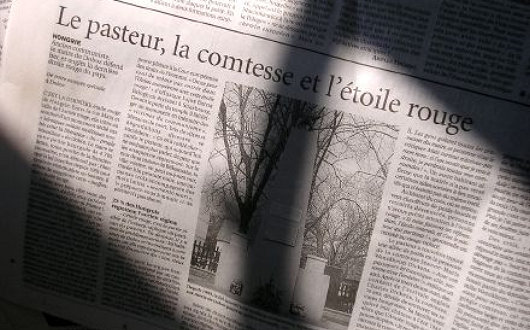
A Bit of Sun
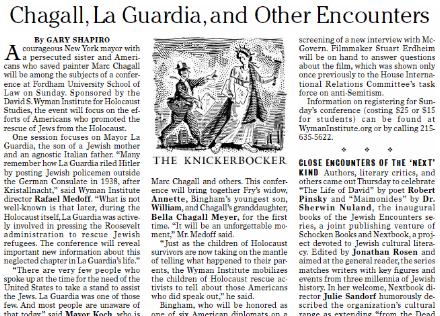

My ownly major aesthetic gripe against the Sun is the layout of the front page of their Friday second section, currently titled ‘Arts+’. (The ‘plus’ presumably refers to the inclusion of the Sports pages towards the end). Below at left is Section II as it appeared in the September 2-4 edition. The sans-serif font is just a tad too Gannett for a publication as esteemed as the Sun. To the right and below it I have placed two proposals for a reform of the Section II front page, both of which, I believe, are much more in keeping with the general aesthetic and demeanor of the rest of the New York Sun.
Which Way Forward for the Sun?
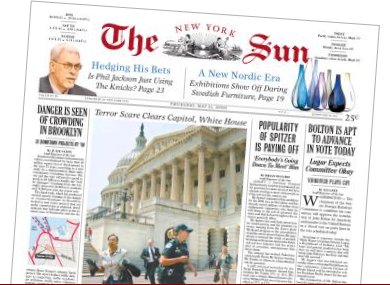
Marty Browne, a loyal reader from Queens, has brought to my attention that a hooplah has taken place in a few media outlets recently concerning our beloved New York Sun. Essentially, two memos written by Robert Messenger, deputy managing editor of the Sun, were somehow leaked to Gawker, Gotham’s flitty rumor mill, and posted on May 11, 2005.
 The two memos deal with the state of the Sun at the moment and highlights some concerns over its long-term future, suggesting something of a ‘back to basics’ course for the three-year old conservative broadsheet. Our friend Mr. Browne was concerned enough to write a letter to the editor cautioning against changing our beloved Sun, bar adding a few more voices from the old right (advice which should be heeded). But having read the memo, I think it offers a frank analysis of the paper today and productive suggestions for the direction it should go in.
The two memos deal with the state of the Sun at the moment and highlights some concerns over its long-term future, suggesting something of a ‘back to basics’ course for the three-year old conservative broadsheet. Our friend Mr. Browne was concerned enough to write a letter to the editor cautioning against changing our beloved Sun, bar adding a few more voices from the old right (advice which should be heeded). But having read the memo, I think it offers a frank analysis of the paper today and productive suggestions for the direction it should go in.
Essentially, what the Sun has to do is decide what it will be. It would be excellent if New York could have a general interest conservative broadsheet newspaper. However, given the overwhelmingly liberal market, I doubt the city’s ability to support such an endeavour; a luxury we sadly cannot afford.
In the mad media market of Manhattan, the most reliable option for the Sun is not as a general interest paper, a more financially-precarious model, but instead to find a niche in which to solidly rest. The weekly New York Observer, only born in the nineties, has a niche which gives it a fairly firm foundation provided it continues to serve it well, and the Sun should take note of that.
Thus the niche market is the way to go. What niche though? In my opinion, the New York Sun should be three things: 1) Conservative, 2) High-brow, 3) Metropolitan.
1) The Conservative Newspaper: The right-minded mustn’t just give up and concede New York as legitimately 100% liberal. This simply would not reflect reality, and the Sun must continue to provide a conservative voice on a higher scale than the populist New York Post.
2) The High-Brow Newspaper: Arts & Letters is already the most flourishing section and long may it continue. James Gardner on great on Architecture and I am absolutely loyal to the architectural historian Francis Morrone’s ‘Abroad in New York’ column every Monday. The Editorial and Opinion sections provide good sound argument and discussion, but could do with expansion.
3) The Metropolitan Newspaper: Of course it must continue to be an intrinsically New York paper. Coverage of the civic, political, and social sides of the city are essentially. This department has been pretty solid and consistent, and should only be augmented.
Should the New York Sun aim to be the conservative, high-brow, metropolitan newspaper, I believe it will be a winning formula, and set the newspaper well along on path towards becoming a great New York institution, if it isn’t one already.
(Continue reading for my thoughts on a few of Mr. Messenger’s points.)
Taki on the Sun

In this week’s Spectator, the ‘poor little Greek boy’ Taki informs us of a feud between the Dorothy Parker Society and the F. Scott Fitzgerald Society. Apparently the DPS invited the FSFS to a big to-do at the Algonquin and the FSFS didn’t even respond. “I get all this info from my favourite Big Bagel paper, the Sun, or the Sharon, as I call it, because of the line it follows where Israel is concerned.” I love the Sun, and I’m very glad Taki has discovered our favorite New York daily. He continues:
Benchley, like Parker, was a founding member of the Algonquin round table, and was known to have spilled more booze than F. Scott ever downed. Unlike the latter, he could hold it. Emerging once from the Waldorf Astoria, he commanded a doorman to get him a taxi. ‘How dare you, Sir,’ came the answer. ‘I am a United States admiral.’ ‘Well, in that case,’ said the well-oiled Benchley, ‘get me a battleship.’
Moving along…
I have not read his book, which is coming out sometime next year, but press reports have it that he was delighted by what he discovered. His accounts apparently have no condescending references to the kitsch or to materialism, which so many of us Europeans refer to every time we write about or mention America. That’s because he went to places like Cooperstown, New York, where the baseball hall of fame museum is located, or to Pennsylvania, among the Amish. (Not much materialism among that lot, that’s for sure.) And a poignant moment, when he is accosted by a Michigan policeman and told to stop loitering and to keep moving — BHL is relieving himself in a field — and he informs the cop that he’s a Frenchman and that he’s following Tocqueville’s footsteps, which results in a pleasant conversation.
Yes, Americans are nice people who want to be nice and do not understand why the Europeans hate them so. Our own Paul Johnson explained it all some weeks ago when he said that, if he were younger, he’d move to the land of plenty. Sure, manners are not an American strong point, nor is its taste for music and movies. But the natives are friendly, vulgar and nice, which is a lot more than I can say for some of us from the old continent.
I seem to have misplaced or thrown out (shudder!) the Speccie with Paul Johnson’s salient words urging and young people with talent in Britain to move to America, but if I do find it, I shall post his words of hope.
Election
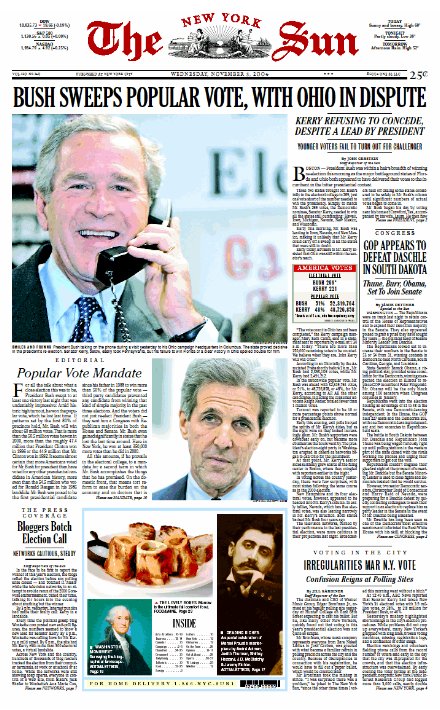
A long morning. A few people filtered into the flat from 1:00am. Kat, Jocie, C., Dave Watt, Rob and Maria. After having some celebratory champagne with future American immigrant D. P. at around 7:00, I finally got to bed around 8:00am and slept until 11:30am. Half past midday now and I need some breakfast/lunch.
Electoral college of beverages consumed: A California’s worth of tea, a New Hampshire of whiskey, and probably about a New York of beer. And an Alaska of bubbly.
Condi versus Hillary in ’08, anyone? God forbid.
Huzzah for the Sun
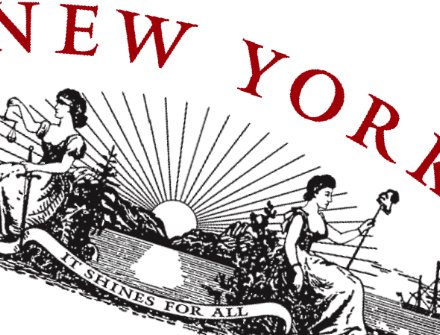
What?!? You still don’t read the New York Sun? Well you’re a fool then. I used to think the Daily Telegraph was the greatest newspaper in the English-speaking world, but now I think it’s got to be the New York Sun. It’s the quality hometown newspaper for the greatest town that ever was.
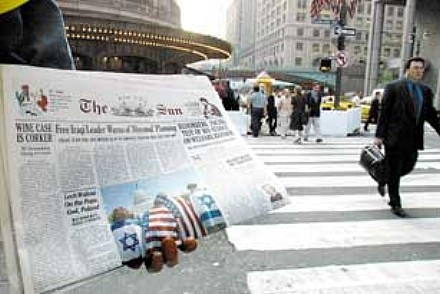 Almost like comparing the City of New York to the New York Times, the Sun is more colorful, less pretentious, loves America, and is a million times more interesting. The only way the Times is more like New York than the Sun is that the Times is so big you can never get through all of it at once.
Almost like comparing the City of New York to the New York Times, the Sun is more colorful, less pretentious, loves America, and is a million times more interesting. The only way the Times is more like New York than the Sun is that the Times is so big you can never get through all of it at once.
In yesterday’s Sun there was a fascinating profile of ‘the Rev’ (photo below), the men’s room attendant in the 21 Club. It was absolutely fascinating to find out about a gem of a man such as he. Reading the Times is arduous and depressing, whilst reading the Sun is informative and pleasing.
Purchasing an online subscription to the Sun was the wisest investment I think I’ve ever made. And economical as well at a mere $16.50 per quarter (with free 4-week trial period), allowing me to cancel for the quarter of the year I can actually buy the paper edition. Most satisfying.

Quoth the Sun: ‘It Shines For All’

Have I ever mentioned how much I enjoy the New York Sun? It’s wonderful to come home to the Great Metropolis and read a broadsheet that doesn’t come off as sanctimonious and elitist (ahem, überliberal New York Times). I’m beginning to think the Sun may even be better than the Daily Telegraph. After all, I don’t believe I’ve ever seen any articles about ‘Posh and Becks’ in the New York Sun.
Like the Mitre, I dare say, it has a layout that is both contemporary and traditional. (There’s also a definite 1920’s aura to the Sun). And most unlike the Times, it is succint, taking up only twenty-two pages to the Times‘s one-hundred and sixteen. Mind you, I’d be the last to complain if it expanded in size. In fact, it could do to grow to perhaps thirty-something pages. But as our old headmaster used to say, to write, you have to be pompous. You have to believe others ought to be reading what you write. And at one-hundred-sixteen pages daily that means the New York Times is one of the most pompous newspapers around. No shocker there.
Search
Instagram: @andcusack
Click here for my Instagram photos.Most Recent Posts
- Waarburg October 2, 2024
- A Prize for the General September 23, 2024
- Articles of Note: 17 September 2024 September 17, 2024
- Equality September 16, 2024
- Rough Notes of Kinderhook September 13, 2024
Most Recent Comments
Book Wishlist
Monthly Archives
Categories

